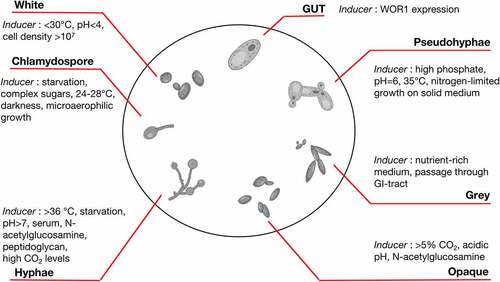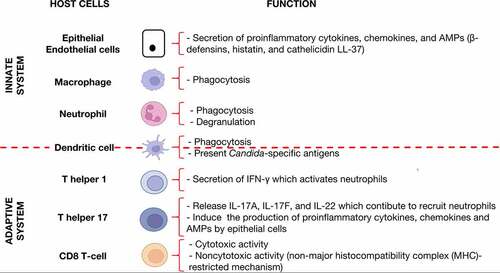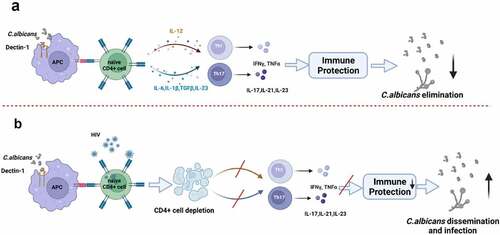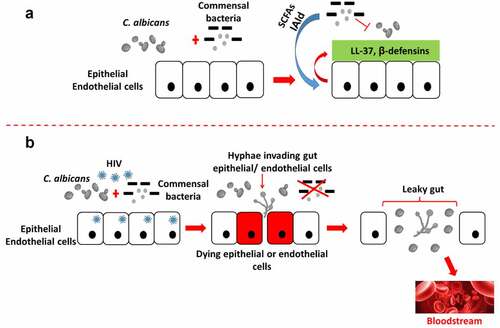Figures & data
Figure 1. Candida albicans existing forms. Adapted from the review by d’Enfert et al.Citation26

Table 1. Common candidiasis and their associated risk factors.
Figure 2. Specific host cells which contribute significantly to controlling C. albicans abundance in the gut.

Table 2. The interactions between C. albicans and bacteria.
Figure 3. Changes of adaptive immunity for C. albicans in HIV-infected individuals. (a) In healthy individuals, commensal C. albicans colonize the host, preferably as a yeast form. They can be recognized, processed, and presented to CD4 + T cells by antigen presenting cells (APCs). Upon activation, naïve CD4+ Th precursor cells differentiate into protective effector T helper cells, Th1 and Th17, which produce multiple cytokines. These cytokines, such as IFN-γ, IL-17, and IL-21, activate immune responses to eliminate or control the growth and dissemination of C. albicans. (b) In HIV-infected individuals, CD4 + T-cells are invaded and depleted by HIV, especially in the intestine where CD4 + T-cells express high levels of the CCR5 co-receptor. Once CD4 + T-cell counts are reduced to threshold values, the effects of immune protection mediated by CD4 + T-cells decrease. In such a scenario, C. albicans would initiate overgrowth and disseminate, thus inducing different types of infection in the human host.

Figure 4. C. albicans interactions with host bacteria in the gut. In the absence of HIV infection, commensal bacterial actions (competition for adhesion sites, secretion of IAld and SCFAs) combined with host epithelial/endothelial cells secretion of β-defensins and LL-37 contribute to control C. albicans proliferation (a). However, during HIV infection, the reduced abundance of commensal bacteria favors C. albicans proliferation, which in turn develops hyphal forms and biofilm on and in-between epithelial/endothelial cells. Consequently, epithelial/endothelial cell integrity is disrupted, leading to their destruction, which further contributes to the establishment of the leaky gut syndrome (b). The epithelial/endothelial disruption eventually represents an “open gate”, so to speak, for C. albicans to disseminate into the bloodstream and thus initiate systemic infection and inflammation. SCFAs, short-chain fatty acids; IAld, indole-3-aldehyde.

Data availability statement
Data sharing is not applicable to this article as no new data were created or analyzed in this study.
